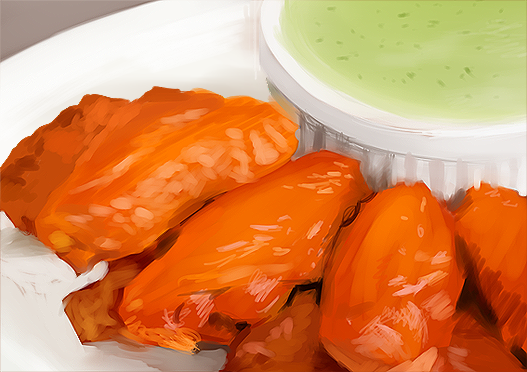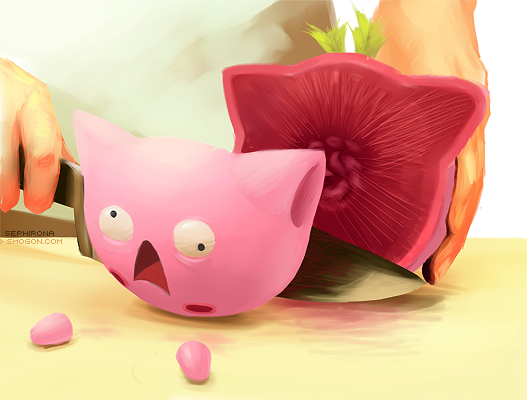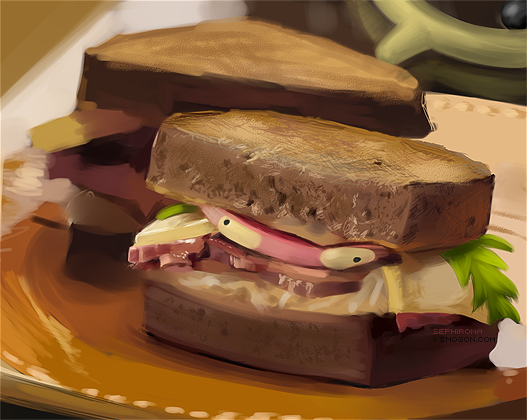Aron Chef: Making the Best of the Worst
| « Previous Article | Home | Next Article » |

Introduction
Some Pokémon are better than others in battle. When it comes to Water-types, for example, Jellicent is good, Manaphy is great, and Luvdisc is, uh, Luvdisc. Not every Pokémon shines in the brutal, unforgiving world of Pokémon battles. There is another arena where some of these lesser Pokémon can prove their worth, though: the dinner plate.
I'll be taking a look at a meal built using four of these rejected Pokémon. As it turns out, you don't need to be viable to be delectable.
The Appetizer: Fire & Ice Delibird Wings

The thing about Delibird's status on the battlefield is that it never really had a chance. Ice is a horrific defensive typing, and Flying just compounds its issues. It has mostly inconsequential resistances to Grass and Bug, a Ground immunity, and a host of weaknesses to common moves. Plus, it loses half its HP switching into Stealth Rock. These are qualities that can cripple Pokémon with as much going for them elsewhere as Articuno. The other thing about Delibird is that it would be still pretty much the worst if it were a Dragon / Steel type. Sure, its typing sucks—but so do its stats, its movepool, and its abilities. Even its signature move, Present, is baffling and useless.
So, yeah, Delibird's kind of a turkey. And, much like the turkey, it's as delicious as it is bad at, um, everything. In the wild, Delibird will be gutted by a long list of predators (for example: Weavile, Mamoswine, or Zubat) if it tries to venture out of its nest, which has led the birds to adopt a very sedentary lifestyle. What their inability to actually do anything without dying means in culinary terms is that Delibird are mostly made of very tender, juicy white meat. The other interesting point is that—perhaps because they're bafflingly festive creatures—Delibird meat actually contains menthol. Quite a bit of it, enough to lend a vague peppermint flavor. I asked a buddy of mine who's a Pokémon biologist how this would happen, and he shrugged and said he "wasn't about to try and ask for a grant to find out why fucking Delibird tastes like breath mints."
So, Delibird makes a great choice for an appetizer intended to bring the heat at the same time it leaves a cool mint flavor on your breath. Fire & Ice Delibird wings are a favorite snack in northeastern Johto, and they just might be yours after you give them a try. Traditionally, Delibird wings fresh from the Ice Cave are deep-fried until golden brown before being tossed in a slightly sweet, very spicy chili sauce—kept just above freezing until it's added—and served. The superb thermal insulation provided as a factor of Delibird's Ice-type allows the wings to stay piping hot even once they're sitting in the sauce. The resulting dish is all about contrast—between the crispy skin of the wings and the soft meat inside; between the ice-cold sauce and the warm wings; between the in-your-face spiciness of the sauce and the cool, refreshing minty flavor of the wings' interiors. If I'm honest, it breaks my heart a little when I see the occasional Trainer trying to use a Delibird in battle—putting a Choice Band on its head and pushing it harder and harder in the hopes that maybe, one day, it might take the opponent more than one move to knock it out. The way I see it, it's just denying the Pokémon its birthright. In battle, Delibird can't strive for anything more impressive than only breaking one or two limbs at a time—but it's a star in the kitchen.
The Salad: Hoppip Green Salad

Trainers are less selective early in their journeys. When you have less to choose from, you're more likely to accept a Pokémon's strong suits in spite of its weaknesses. Lillipup isn't the strongest or the fastest Normal-type out there even after evolution, but many a Unovan youth has captured one of the almost omnipresent little canines and found it a loyal friend and a stalwart ally nonetheless. Strangely, though, Johto trainers setting out from New Bark Town seldom give Hoppip a second glance, despite its hypothetically useful Grass / Flying typing and its range, known to extend as near as Route 29.
The reason for this is, of course, that Hoppip is thoroughly useless. The same Hoppip that flutter onto Route 29 know only Splash; they don't pick up any means of attack until Tackle at level 8, and even then they'll evolve before they're able to utilize their typing for any of their attacks. Even without the limitations of their movepool, Hoppip are still frail creatures, shredded to bits by even light blows and incapable of inflicting substantial damage on any foes. Evolution does them no favors; Skiploom and Jumpluff are impressively fast for, you know, plants, but they're still just too delicate to do much good in battle, and they're not nearly good enough at supporting their more capable teammates to make up for that. Also, they're supposed to blow miles away on the slightest breeze, but they can't even learn Fly. So, it's a Pokémon that goes flying at every time except for when you want it to.
These qualities make Hoppip a dubious bet for a Trainer, but as it turns out the delicate little vegetable has a lot going for it from a culinary standpoint. The leaves themselves are crisp and refreshing, with a mild flavor that makes them a versatile base for salads. What's more, they're packed with beta-Carotene, iron, calcium, and vitamins A and C. The pink, immature root body itself has a delicate, sweet flavor and surprisingly high protein content—Hoppip has been called a wonder food, as a matter of fact. Do note, though, that the nutritional qualities and subtle flavors that make Hoppip so appealing tend to deteriorate quickly after harvest.
Some general advice on working with Hoppip: don't buy canned, frozen, or pre-sliced Hoppip; your grocer's produce section should house fresh, live Hoppip, and those are what you want to use. Purchase a Hoppip only the night you intend to use it, and don't cut into it until you're ready to prepare a dish. When you're ready to begin, separate the greens from the tuber first to prevent the Hoppip from damaging them or escaping, then slice off the limbs and ears and extract the face and central nervous system using a melon baller. You may want to wear earmuffs—for a Pokémon that isn't technically an animal, these things sure can scream.
A traditional Hoppip green salad, as are common in Violet City during the spring, is a fairly simple affair. Hoppip greens are topped with the shredded tuber, and vinegar is drizzled over top. It's light, refreshing, and pleasantly—but not overpoweringly—sweet. High-end restaurants in more metropolitan areas may add other produce, such as dwarf Cherubi berries, to complement the Hoppip's own flavor. Personally, I'm a traditionalist; Hoppip green salad is intended to serve as a side salad next to a heavier entree, so I'd rather not overcomplicate things.
The Entree: Barbecued Stantler Sandwiches

The Trainer's first response to this dish is likely, "What the hell's a Stantler?" shortly before they recall the dopey deer thing they caught south of Ecruteak City and crammed into their PC Box, never to see it again. Stantler isn't as aggressively worthless on the battlefield as Hoppip or Delibird, but it's not good either; it has enough Attack and Special Attack to do some damage, but not enough to pose a real threat, and it has enough Speed to keep up with foes while it's not really capable of outrunning anything significant. It's just kind of there, really; not good enough to use, not bad enough to receive the vicious mockery afforded to Pokémon like Unown. It's a vaguely offensive Normal-type that also learns Hypnosis for some reason, and that's all; it seems destined to be forgotten.
If you ask anyone in Ecruteak about Stantler, though, you'll get a different response: as it turns out, the Pokémon that so many Trainers manage to forget they own is a favorite for holiday feasts. Despite their complete failure to translate any of these properties to battle, Stantler are hardy, tough animals, well adapted to the mountainous forests they call home; they're large, muscular, and make excellent game meat. Stantler venison isn't too dissimilar from Tauros, but it's much richer and possesses a fine, almost silky texture. Most of the cuts have a great deal of connective tissue, making them too tough for grilling, but Stantler is ideal for barbecue, as that collagen breaks down to form gelatin that keeps the meat moist throughout a long cooking process. The result is an incredibly tender, moist piece of meat that falls apart on its own.
Traditionally, the brisket is what's used for this dish, but it can work well with many of the other tougher cuts on a Stantler, such as the shanks. The brisket is marinated in a sweet, spicy sauce—this is often a recipe passed down through a family line, but most include common ingredients such as soy sauce, brown sugar, and black pepper—overnight before being put on a spit and cooked over a wood fire until the roast starts to fall apart. It's then plated and allowed a short time to set, before it's sliced and served on fresh bread. A memorable, festive meal from a decidedly unmemorable Pokémon. In times past, Stantler would typically be brought to the table using tools carved from the animal's own antlers; now, the secondary market for those means that it's more common to serve Stantler using the same stainless-steel cutlery used everywhere else in the kitchen.
The Dessert: Candied Sunkern

I'm not actually sure what purpose Sunkern serves in its ecosystem. It's immobile, laughably weak, and...occasionally falls from the sky for some reason? Where do Sunkern even come from? Maybe they're really shitty aliens. That would explain why Sunflora are so horrifying and awful, at any rate. Still, though—if these are the invasion force, we're good. The worst-case scenario is that one lands in a nice, sunny spot, and can use its vast 30/30/30 offenses to fire off Solar Power-boosted Solar Beams until it burns up. Or, uh, something steps on it. Other than that, all they really do is shake their leaves around in a manner that Pokémon psychologists tell me is intended to be threatening. Also, they somehow subsist off of dew. This is probably a factor in why they're so utterly worthless in battle.
The only reason these things haven't been eaten to extinction is the fact that they're clearly extraterrestrial in origin. They're basically just 12-inch-tall masses of starch and sugar; they're defenseless enough that any Pokémon that shares their range is going to list "Sunkern" as one of its food sources. I mean, hell—they're supposed to be Seed Pokémon, but they don't even have a hard shell. They're also a staple food in central Johto for just that reason; while efforts to farm Sunkern haven't been too successful, they're pretty much free food that plummets from the heavens every morning. You can grind them into flour, roast them, press them for oil, slice and grill them—but we want dessert, right? So we're going to be looking at one of my favorite Goldenrod City street foods, candied Sunkern.
Let's be clear here: you probably want to buy candied Sunkern from a candy shop instead of trying to make it. It's not hard or complicated, it just takes a really long time. It's a fairly simple process, though. Slice your Sunkern into long, thin strips. Exactly how fine these are depends on the area, but Goldenrod candied Sunkern typically goes for just 1cm thickness across. It really can vary, though; Unovan recipes actually dice the Sunkern instead. Next, boil the prepared Sunkern before steeping it in a fresh, hot sugar syrup until it's absorbed the sugar. Like with Hoppip, for best results you want to use live Sunkern. Luckily, Sunkern are as bad at screaming as everything else; it's more of a low, plaintive whine that's not likely to cause any real difficulty.
Then you just do this again, and again, and again, and again, all while steadily ratcheting up the concentration of the syrup. This normally goes on for three months or so. This process converts Sunkern's starchy flesh into a delightful crystalline candy while, at the same time, removing moisture and repelling the microorganisms that, like every other kind of organisms, look at Sunkern as essentially free food. The result is an incredibly sweet, indulgent candy with just a hint of Sunkern's natural earthy flavor. It's a good choice for dessert or simply for snacking, and it can also be used as an ingredient in many further sweets.
Conclusion
These are just four of the many Pokémon that have been maligned for being useless when they're anything but. If you've ever had curried Basculin or baked Carnivine, you should know just how fantastic a lot of these Pokémon are once you take them off the battlefield and put them in the hands of a skilled chef. I could go on for ages if it weren't for the fact that I haven't been paid for this column yet; as is, I'll most likely see you next in "Objecteon: So You Want to Hire a Pokémon Lawyer."
Also, you may have noticed that these are all Johto-native species. As it happens, Johto is an environment that is, apparently, rich in useless bullshit.
| « Previous Article | Home | Next Article » |